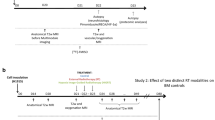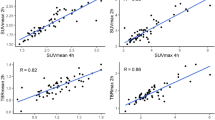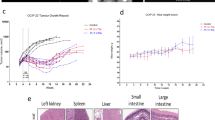Abstract
Tc-99m-HL91 is a hypoxia imaging biomarker. The aim of this study was to investigate the value of Tc-99m-HL91 imaging for hypoxia-induced cytosine deaminase (CD)/5-fluorocytosine (5-FC) gene therapy in a murine lung tumor model. C57BL/6 mice were implanted with Lewis lung carcinoma cells transduced with the hypoxia-inducible promoter-driven CD gene (LL2/CD) or luciferase gene (LL2/Luc) serving as the control. When tumor volumes reached 100 mm3, pretreatment images were acquired after injection of Tc-99m-HL91. The mice were divided into low and high hypoxic groups based on the tumor-to-non-tumor ratio of Tc-99m-HL91. They were injected daily with 5-FC (500 mg kg−1) or the vehicle for 1 week. When tumor volumes reached 1000 mm3, autoradiography and histological examinations were performed. Treatment with 5-FC delayed tumor growth and enhanced the survival of mice bearing high hypoxic LL2/CD tumors. The therapeutic effect of hypoxia-induced CD/5-FC gene therapy was more pronounced in high hypoxic tumors than in low hypoxic tumors. This study provides the first evidence that Tc-99m-HL91 can serve as an imaging biomarker for predicting the treatment responses of hypoxia-regulated CD/5-FC gene therapy in animal tumor models. Our results suggest that hypoxia imaging using Tc-99m-HL91 has the predictive value for the success of hypoxia-directed treatment regimens.
This is a preview of subscription content, access via your institution
Access options
Subscribe to this journal
Receive 12 print issues and online access
$259.00 per year
only $21.58 per issue
Buy this article
- Purchase on Springer Link
- Instant access to full article PDF
Prices may be subject to local taxes which are calculated during checkout



Similar content being viewed by others
References
Gatenby RA, Kessler HB, Rosenblum JS, Coia LR, Moldofsky PJ, Hartz WH et al. Oxygen distribution in squamous cell carcinoma metastases and its relationship to outcome of radiation therapy. Int J Radiat Oncol Biol Phys 1988; 14: 831–838.
Hockel M, Schlenger K, Knoop C, Vaupel P . Oxygenation of carcinomas of the uterine cervix: evaluation by computerized O2 tension measurements. Cancer Res 1991; 51: 6098–6102.
Vaupel P, Schlenger K, Knoop C, Hockel M . Oxygenation of human tumors: evaluation of tissue oxygen distribution in breast cancers by computerized O2 tension measurements. Cancer Res 1991; 51: 3316–3322.
Brizel DM, Scully SP, Harrelson JM, Layfield LJ, Bean JM, Prosnitz LR et al. Tumor oxygenation predicts for the likelihood of distant metastases in human soft tissue sarcoma. Cancer Res 1996; 56: 941–943.
Dachs GU, Patterson AV, Firth JD, Ratcliffe PJ, Townsend KM, Stratford IJ et al. Targeting gene expression to hypoxic tumor cells. Nat Med 1997; 3: 515–520.
Shiau AL, Yang HM, Wu P, Wu CL . Provision of positive and negative selections in retroviral vectors containing the cytosine deaminase gene. Gene Ther 1998; 5: 1571–1574.
Lee CH, Wu CL, Shiau AL . Hypoxia-induced cytosine deaminase gene expression for cancer therapy. Human Gene Ther 2007; 18: 27–38.
Kievit E, Bershad E, Ng E, Sethna P, Dev I, Lawrence TS et al. Superiority of yeast over bacterial cytosine deaminase for enzyme/prodrug gene therapy in colon cancer xenografts. Cancer Res 1999; 59: 1417–1421.
Kuriyama S, Kikukawa M, Masui K, Okuda H, Nakatani T, Sakamoto T et al. Cytosine deaminase/5-fluorocytosine gene therapy can induce efficient anti-tumor effects and protective immunity in immunocompetent mice but not in athymic nude mice. Int J Cancer 1999; 81: 592–597.
Hanna NN, Mauceri HJ, Wayne JD, Hallahan DE, Kufe DW, Weichselbaum RR . Virally directed cytosine deaminase/5-fluorocytosine gene therapy enhances radiation response in human cancer xenografts. Cancer Res 1997; 57: 4205–4209.
Beck R, Roper B, Carlsen JM, Huisman MC, Lebschi JA, Andratschke N et al. Pretreatment 18F-FAZA PET predicts success of hypoxia-directed radiochemotherapy using tirapazamine. J Nucl Med 2007; 48: 973–980.
Eschmann SM, Paulsen F, Reimold M, Dittmann H, Welz S, Reischl G et al. Prognostic impact of hypoxia imaging with 18F-misonidazole PET in non-small cell lung cancer and head and neck cancer before radiotherapy. J Nucl Med 2005; 46: 253–260.
Rischin D, Hicks RJ, Fisher R, Binns D, Corry J, Porceddu S et al. Prognostic significance of [18F]-misonidazole positron emission tomography-detected tumor hypoxia in patients with advanced head and neck cancer randomly assigned to chemoradiation with or without tirapazamine: a substudy of Trans-Tasman Radiation Oncology Group Study 98.02. J Clin Oncol 2006; 24: 2098–2104.
Dehdashti F, Grigsby PW, Mintun MA, Lewis JS, Siegel BA, Welch MJ . Assessing tumor hypoxia in cervical cancer by positron emission tomography with 60Cu-ATSM: relationship to therapeutic response-a preliminary report. Int J Radiat Oncol Biol Phys 2003; 55: 1233–1238.
Iyer RV, Haynes PT, Schneider RF, Movsas B, Chapman JD . Marking hypoxia in rat prostate carcinomas with beta-D-[125I]azomycin galactopyranoside and [99mTc]HL-91: correlation with microelectrode measurements. J Nucl Med 2001; 42: 337–344.
Siim BG, Laux WT, Rutland MD, Palmer BN, Wilson WR . Scintigraphic imaging of the hypoxia marker (99 m)technetium-labeled 2,2′-(1,4-diaminobutane)bis(2-methyl-3-butanone) dioxime (99mTc-labeled HL-91; prognox): noninvasive detection of tumor response to the antivascular agent 5,6-dimethylxanthenone-4-acetic Acid. Cancer Res 2000; 60: 4582–4588.
Kinuya S, Yokoyama K, Li XF, Bai J, Watanabe N, Shuke N et al. Hypoxia-induced alteration of tracer accumulation in cultured cancer cells and xenografts in mice: implications for pre-therapeutic prediction of treatment outcomes with (99 m)Tc-sestamibi, (201)Tl chloride and (99 m)Tc-HL91. Eur J Nucl Med Mol Imaging 2002; 29: 1006–1011.
Van De Wiele C, Versijpt J, Dierckx RA, Moerman M, Lemmerling M, D′Asseler Y et al. 99Tc(m) labelled HL91 versus computed tomography and biopsy for the visualization of tumour recurrence of squamous head and neck carcinoma. Nucl Med Commun 2001; 22: 269–275.
Lee BF, Chiu NT, Hsia CC, Shen LH . Accumulation of Tc-99 m HL91 in tumor hypoxia: in vitro cell culture and in vivo tumor model. Kaohsiung J Med Sci 2008; 24: 461–472.
Mees G, Dierckx R, Vangestel C, Van de Wiele C . Molecular imaging of hypoxia with radiolabelled agents. Eur J Nucl Med Mol Imaging 2009; 36: 1674–1686.
Archer CM, Edwards B, Kelly JD, King AC, Burke JF, Riley ALM . Technetium labeled agents for imaging tissue hypoxia in vivo. In: Nicolini M, Bandoli G, Mazzi U (eds). Technetium and Rhenium in Chemistry and Nuclear Medicine. SG Editoriali: Padova, 1995 pp 535–539.
Cook GJR, Houston S, Barrington SF, Fogelman I . Technetium-99m-labeled HL91 to identify tumor hypoxia: correlation with fluorine-18-FDG. J Nucl Med 1998; 39: 99–103.
Honess DJ, Hill SA, Collingridge DR, Edwards B, Brauers G, Powell NA et al. Preclinical evaluation of the novel hypoxic marker 99mTc-HL91 (prognox) in murine and xenograft systems in vivo. Int J Radiat Oncol Biol Phys 1998; 42: 731–735.
Tatsumi M, Yutani K, Kusuoka H, Nishimura T . Technetium-99 m HL91 uptake as a tumor hypoxia marker: relationship to tumour blood flow. Eur J Nucl Med 1999; 26: 91–94.
Acknowledgements
We thank Gang Ting and Shiaw-Pyng Wey for helpful conversations on experimental design. We also thank Julie Sun, Yuen-Shin Chao and Ting-Jyun Jhuo for their technical assistance, and Pei-Sing Liou for her secretarial help with the manuscript. We are grateful to Wei-Ming Wang for providing the statistical consulting services from the Biostatistics Consulting Center, National Cheng Kung University Hospital and Professor Iain Bruce for English-editing. This work was supported in part by Grants from the National Science Council (NSC96-2321-B-006-004-MY2, NSC-95-NU-7-006-001 and NSC-94-NU-7-006-003), Taiwan.
Author information
Authors and Affiliations
Corresponding author
Ethics declarations
Competing interests
The authors declare no conflict of interest.
Rights and permissions
About this article
Cite this article
Lee, BF., Lee, CH., Chiu, NT. et al. Hypoxia imaging predicts success of hypoxia-induced cytosine deaminase/5-fluorocytosine gene therapy in a murine lung tumor model. Cancer Gene Ther 19, 255–262 (2012). https://doi.org/10.1038/cgt.2011.87
Received:
Revised:
Accepted:
Published:
Issue Date:
DOI: https://doi.org/10.1038/cgt.2011.87



